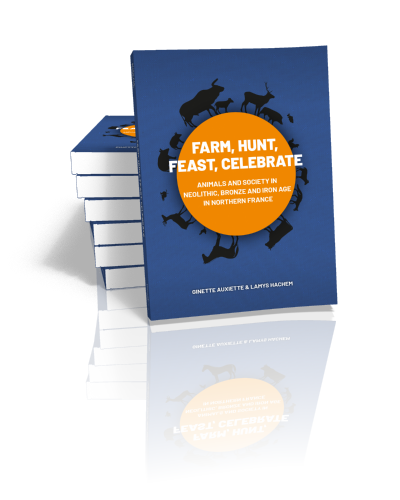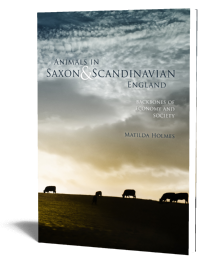Farm, Hunt, Feast, Celebrate
Animals and Society in Neolithic, Bronze and Iron Age Northern France
Ginette Auxiette & Lamys Hachem | 2021

Farm, Hunt, Feast, Celebrate
Animals and Society in Neolithic, Bronze and Iron Age Northern France
Ginette Auxiette & Lamys Hachem | 2021
Paperback ISBN: 9789464260212 | Hardback ISBN: 9789464260229 | Imprint: Sidestone Press | Format: 210x280mm | 342 pp. | Language: English | 70 illus. (bw) | 147 illus. (fc) | Keywords: archaeozoology; Neolithic; Bronze Age; Iron Age; Northern France; prehistoric animal husbandry; animal remains; herding; hunting; funerary practices; communal meals; feasting; depositional practices | download cover
Read online 530 times
- Digital & Online access
-
Buy via Sidestone (EU & UK)
-
Buy via our Distributors (WORLD)
For non-EU or UK destinations you can buy our books via our international distributors. Although prices may vary this will ensure speedy delivery and reduction in shipping costs or import tax. But you can also order with us directly via the module above.
UK international distributor
USA international distributor
-
Bookinfo
Paperback ISBN: 9789464260212 | Hardback ISBN: 9789464260229 | Imprint: Sidestone Press | Format: 210x280mm | 342 pp. | Language: English | 70 illus. (bw) | 147 illus. (fc) | Keywords: archaeozoology; Neolithic; Bronze Age; Iron Age; Northern France; prehistoric animal husbandry; animal remains; herding; hunting; funerary practices; communal meals; feasting; depositional practices | download cover
Read online 530 times

We will plant a tree for each order containing a paperback or hardback book via OneTreePlanted.org.
Building on the experience of twenty-five years of fieldwork and archaeozoological analyses carried out during research projects in various regions of northern France, this book examines animal husbandry and hunting practices over the 5000 year period from the first sedentary groups to the more evolved societies, corresponding to the Neolithic, Bronze and Iron Age.
This approach is based on the processing of a very large amount of data, from sources as varied as settlements, assembly places, cemeteries and other distinctive sites. The study looks in detail at domestic consumption in houses, villages and enclosures, as well as addressing feasting, ceremonial deposition and the role of animals in the funerary sphere.
Intra-site and inter-site spatial analysis of a portion of the data has also been one of the keys to gaining certain levels of understanding and interpretation of the societies in question.
By examining the evidence at different spatial scales, from site to territorial level, a picture can be outlined of the probable social mechanisms at work. This approach highlights the changing complexity of practices involving people and animals.
This book offers a contribution to the broad field of research into how people interact with their natural, cultural and social environments.
1 Chrono-cultural background
1.1 The Neolithic
1.2 Bronze Age
1.3 Iron Age
2 Domestic consumption on habitation sites: houses, villages, enclosures, un-enclosed settlements
2.1 The Neolithic
2.1.1 The Early Neolithic
2.1.1.1 Villages: rules and variations
2.1.1.2 Cooking and eating within the home
2.1.1.3 Forests, rivers and pastures: the natural resources
2.1.1.4 The siting of the house within the village
2.1.1.5 An overview of the variation in species during the RFBS and BVSG
2.1.1.6 Comparisons with LBK sites elsewhere in Europe
2.1.2 The Middle Neolithic
2.1.2.1 The various types of settlements
2.1.2.2 The Middle Neolithic I
2.1.2.3 The Middle Neolithic II
2.1.3 The Late Neolithic
2.1.3.1 An imbalance in favour of funerary contexts
2.1.3.2 Different types of occupation
2.1.4 The Final Neolithic
2.1.4.1 Fresh settlement evidence
2.1.4.2 Faunal remains from settlement sites
2.2 The Metal Ages
2.2.1 The Bronze Age
2.2.1.1 Production and consumption on farmstead sites
2.2.1.2 Production and consumption on large sites in upland areas and plains
2.2.2 The Iron Age
2.2.2.1 Consumption of animals on Late Hallstatt/Early La Tène farms (530-325 BCE)
2.2.2.2 The fauna of Middle La Tène farms
2.2.2.3 The fauna of Late La Tène farms and oppida (180-20 BCE)
3 Collective meals
3.1 The Neolithic
3.1.1 Self-sufficiency and sharing between households in the Early Neolithic
3.1.2 Middle Neolithic enclosures as places of assembly
3.1.2.1 The Middle Neolithic I
3.1.2.2 The Middle Neolithic II
3.1.3 The Late Neolithic
3.1.4 The Final Neolithic
3.2 The Bronze Age and Iron Age
3.2.1 Exceptional consumption: sheep bones in silos
3.2.2 Collective meals from the Bronze Age (Hallstatt A and C) to the Late La Tène (La Tène C2/D2)
3.2.2.1 Fauna from high status Bronze Age enclosure sites
3.2.2.2 Fauna from high status Iron Age sites
3.2.2.3 Evidence for collective meals in the La Tène D2b
4 Cultural manifestations
4.1 Deposits containing entire animals, or animal parts, in “domestic” contexts
4.2 The Neolithic
4.2.1 The Early Neolithic
4.2.1.1 A ceremonial enclosure
4.2.1.2 Object-Signs
4.2.2 The Middle Neolithic
4.2.2.1 Turtle shells
4.2.2.2 A monumental building
4.2.2.3 Deposits in enclosures
4.2.2.4 Amulets
4.2.2.5 Burnt bones
4.2.3 The Late Neolithic
4.2.3.1 Wild animals in deep pits
4.2.3.2 Wild horse
4.3 Bronze Age and Iron Age
4.3.1 Simple deposits
4.3.1.1 The deposition of dog at Ifs
4.3.2 Complex deposits
4.3.2.1 Combined deposition of humans and animals in settlements contexts
4.4 Animal deposits in Y- and W-shaped pits: The Neolithic and Bronze Age
5 The animal in the funerary realm
5.1 The Neolithic
5.1.1 The Early Neolithic
5.1.1.1 Burials
5.1.2 The Middle Neolithic
5.1.2.1 Sheep, cattle and pigs
5.1.2.2 Fox, wolf and birds
5.1.2.3 Wild boar tusks and hares’ feet
5.1.3 The Late Neolithic and Final Neolithic
5.1.3.1 Carnivores and suinae
5.2 The Bronze Age and the Iron Age
5.2.1 Animal deposits in cremation and inhumation burials, in Bronze Age ring ditches
5.2.2 Faunal deposits in La Tène graves
6 Throwing light on social mechanisms
6.1 An overview of Neolithic socio-economic systems
6.1.1 The Early Neolithic
6.1.1.1 Livestock at the centre of wealth, clans and tradition
6.1.1.2 Hunting, a marker of gender
6.1.1.3 A dual society
6.1.2 The Middle Neolithic
6.1.2.1 A tendency towards ostentation
6.1.2.2 Clues to the activities that took place in enclosures
6.1.3 The Late Neolithic
6.1.3.1 The collective and the individual
6.1.3.2 Status differentiation
6.1.4 The Final Neolithic
6.1.5 Conclusions regarding Neolithic social system
6.2 An overview of metal Ages socio economic systems
6.3 Evolution of cultual expressions through the ages
6.4 The question of animal sacrifice through the ages
7 General conclusion

Dr. Ginette Auxiette
Ginette Auxiette has a Ph.D. in archaeology from the Université de Paris I, Panthéon-Sorbonne and is currently a researcher specialized in archaeozoology with the French National Institute for Preventive Archaeological Research (INRAP). Her research carried out with the team Trajectoires «De la sédentarisation à l’Etat» (UMR 8215 of CNRS) deals with different aspects of material culture in the Metal Ages in the northern half of France.

Dr. Lamys Hachem
Lamys Hachem graduated with a Ph.D. in archelogy from the Université de Paris I, Panthéon-Sorbonne where she also has been teaching for several years. She is currently a senior researcher in archeozoology and pre-history at the French National Institute for Preventive Archaeological Research (INRAP), the largest French center for archaeological research and one of the largest in Europe.
Abstract:
Building on the experience of twenty-five years of fieldwork and archaeozoological analyses carried out during research projects in various regions of northern France, this book examines animal husbandry and hunting practices over the 5000 year period from the first sedentary groups to the more evolved societies, corresponding to the Neolithic, Bronze and Iron Age.
This approach is based on the processing of a very large amount of data, from sources as varied as settlements, assembly places, cemeteries and other distinctive sites. The study looks in detail at domestic consumption in houses, villages and enclosures, as well as addressing feasting, ceremonial deposition and the role of animals in the funerary sphere.
Intra-site and inter-site spatial analysis of a portion of the data has also been one of the keys to gaining certain levels of understanding and interpretation of the societies in question.
By examining the evidence at different spatial scales, from site to territorial level, a picture can be outlined of the probable social mechanisms at work. This approach highlights the changing complexity of practices involving people and animals.
This book offers a contribution to the broad field of research into how people interact with their natural, cultural and social environments.
Contents
1 Chrono-cultural background
1.1 The Neolithic
1.2 Bronze Age
1.3 Iron Age
2 Domestic consumption on habitation sites: houses, villages, enclosures, un-enclosed settlements
2.1 The Neolithic
2.1.1 The Early Neolithic
2.1.1.1 Villages: rules and variations
2.1.1.2 Cooking and eating within the home
2.1.1.3 Forests, rivers and pastures: the natural resources
2.1.1.4 The siting of the house within the village
2.1.1.5 An overview of the variation in species during the RFBS and BVSG
2.1.1.6 Comparisons with LBK sites elsewhere in Europe
2.1.2 The Middle Neolithic
2.1.2.1 The various types of settlements
2.1.2.2 The Middle Neolithic I
2.1.2.3 The Middle Neolithic II
2.1.3 The Late Neolithic
2.1.3.1 An imbalance in favour of funerary contexts
2.1.3.2 Different types of occupation
2.1.4 The Final Neolithic
2.1.4.1 Fresh settlement evidence
2.1.4.2 Faunal remains from settlement sites
2.2 The Metal Ages
2.2.1 The Bronze Age
2.2.1.1 Production and consumption on farmstead sites
2.2.1.2 Production and consumption on large sites in upland areas and plains
2.2.2 The Iron Age
2.2.2.1 Consumption of animals on Late Hallstatt/Early La Tène farms (530-325 BCE)
2.2.2.2 The fauna of Middle La Tène farms
2.2.2.3 The fauna of Late La Tène farms and oppida (180-20 BCE)
3 Collective meals
3.1 The Neolithic
3.1.1 Self-sufficiency and sharing between households in the Early Neolithic
3.1.2 Middle Neolithic enclosures as places of assembly
3.1.2.1 The Middle Neolithic I
3.1.2.2 The Middle Neolithic II
3.1.3 The Late Neolithic
3.1.4 The Final Neolithic
3.2 The Bronze Age and Iron Age
3.2.1 Exceptional consumption: sheep bones in silos
3.2.2 Collective meals from the Bronze Age (Hallstatt A and C) to the Late La Tène (La Tène C2/D2)
3.2.2.1 Fauna from high status Bronze Age enclosure sites
3.2.2.2 Fauna from high status Iron Age sites
3.2.2.3 Evidence for collective meals in the La Tène D2b
4 Cultural manifestations
4.1 Deposits containing entire animals, or animal parts, in “domestic” contexts
4.2 The Neolithic
4.2.1 The Early Neolithic
4.2.1.1 A ceremonial enclosure
4.2.1.2 Object-Signs
4.2.2 The Middle Neolithic
4.2.2.1 Turtle shells
4.2.2.2 A monumental building
4.2.2.3 Deposits in enclosures
4.2.2.4 Amulets
4.2.2.5 Burnt bones
4.2.3 The Late Neolithic
4.2.3.1 Wild animals in deep pits
4.2.3.2 Wild horse
4.3 Bronze Age and Iron Age
4.3.1 Simple deposits
4.3.1.1 The deposition of dog at Ifs
4.3.2 Complex deposits
4.3.2.1 Combined deposition of humans and animals in settlements contexts
4.4 Animal deposits in Y- and W-shaped pits: The Neolithic and Bronze Age
5 The animal in the funerary realm
5.1 The Neolithic
5.1.1 The Early Neolithic
5.1.1.1 Burials
5.1.2 The Middle Neolithic
5.1.2.1 Sheep, cattle and pigs
5.1.2.2 Fox, wolf and birds
5.1.2.3 Wild boar tusks and hares’ feet
5.1.3 The Late Neolithic and Final Neolithic
5.1.3.1 Carnivores and suinae
5.2 The Bronze Age and the Iron Age
5.2.1 Animal deposits in cremation and inhumation burials, in Bronze Age ring ditches
5.2.2 Faunal deposits in La Tène graves
6 Throwing light on social mechanisms
6.1 An overview of Neolithic socio-economic systems
6.1.1 The Early Neolithic
6.1.1.1 Livestock at the centre of wealth, clans and tradition
6.1.1.2 Hunting, a marker of gender
6.1.1.3 A dual society
6.1.2 The Middle Neolithic
6.1.2.1 A tendency towards ostentation
6.1.2.2 Clues to the activities that took place in enclosures
6.1.3 The Late Neolithic
6.1.3.1 The collective and the individual
6.1.3.2 Status differentiation
6.1.4 The Final Neolithic
6.1.5 Conclusions regarding Neolithic social system
6.2 An overview of metal Ages socio economic systems
6.3 Evolution of cultual expressions through the ages
6.4 The question of animal sacrifice through the ages
7 General conclusion

Dr. Ginette Auxiette
Ginette Auxiette has a Ph.D. in archaeology from the Université de Paris I, Panthéon-Sorbonne and is currently a researcher specialized in archaeozoology with the French National Institute for Preventive Archaeological Research (INRAP). Her research carried out with the team Trajectoires «De la sédentarisation à l’Etat» (UMR 8215 of CNRS) deals with different aspects of material culture in the Metal Ages in the northern half of France.

Dr. Lamys Hachem
Lamys Hachem graduated with a Ph.D. in archelogy from the Université de Paris I, Panthéon-Sorbonne where she also has been teaching for several years. She is currently a senior researcher in archeozoology and pre-history at the French National Institute for Preventive Archaeological Research (INRAP), the largest French center for archaeological research and one of the largest in Europe.
- Digital & Online access
-
Buy via Sidestone (EU & UK)
-
Buy via our Distributors (WORLD)
For non-EU or UK destinations you can buy our books via our international distributors. Although prices may vary this will ensure speedy delivery and reduction in shipping costs or import tax. But you can also order with us directly via the module above.
UK international distributor
USA international distributor
- Browse all books by subject
-
Search all books

We will plant a tree for each order containing a paperback or hardback book via OneTreePlanted.org.
You might also like:
© 2025 Sidestone Press KvK nr. 28114891 Privacy policy Sidestone Newsletter Terms and Conditions (Dutch)








